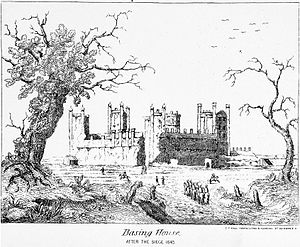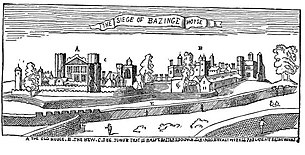| Siege of Basing House | |||||||
|---|---|---|---|---|---|---|---|
| Part of the First English Civil War | |||||||
 Basing House after the siege | |||||||
| |||||||
| Belligerents | |||||||
|
|
| ||||||
| Commanders and leaders | |||||||
| John Paulet, 5th Marquess of Winchester | Oliver Cromwell | ||||||
| Strength | |||||||
| Unknown | 7,000+ | ||||||
| Casualties and losses | |||||||
| 400 killed | 2,000 killed | ||||||

The siege of Basing House near Basingstoke in Hampshire, was a Parliamentarian victory late in the First English Civil War. Whereas the title of the event may suggest a single siege, there were in fact three major engagements. John Paulet, 5th Marquess of Winchester owned the House and as a committed Royalist garrisoned it in support of King Charles I, as it commanded the road from London to the west through Salisbury.
The first engagement was in November 1643, when Sir William Waller at the head of an army of about 7,000 attempted to take Basing House by direct assault. After three failed attempts it became obvious to him that his troops lacked the necessary resolve, and with winter fast approaching Waller retreated back to a more friendly location.
Early in 1644 the Parliamentarians attempted to arrange the secret surrender of Basing House with Lord Edward Paulet, the Marquess of Winchester's younger brother, but the plot was discovered.
Parliamentary forces continued the siege by garrisons on the static approaches to Basing House to stop the Royalists foraging and relief convoys getting through. Then on 4 June 1644, Colonel Richard Norton using Parliamentary troops from the Hampshire garrisons closely invested Basing House and attempted to starve the garrison into submission. This siege was broken on 12 September 1644 when a relief column under the command of Colonel Henry Gage broke through parliamentary lines. Having resupplied the garrison he did not tarry but left the next day and returned to Royalist lines. The Parliamentarians reinvested the place but by the middle of November threatened by a Royalist army and his besieging force decimated by disease Waller ended the investment. Five days later on 20 November Gage arrived with fresh supplies.
The final siege took place in October 1645. Oliver Cromwell joined parliamentary forces besieging the House with his own men and a siege train of heavy guns. They quickly breached the defences and on the morning of 14 October 1645 the House was successfully stormed. As the garrison had refused to surrender before the assault—during the two years of the siege, upwards of 2,000 Parliamentarians were slain.[1]—the attackers, who had little sympathy for those they perceived to be Roman Catholics, killed about a quarter of the 400 members of the garrison, including ten priests (six of whom were killed during the assault and four others held to be executed later).
During the assault the House caught fire and was badly damaged. What remained was "totally slighted and demolished" by order of Parliament, with the stones of the House offered free to anyone who would cart them away.

